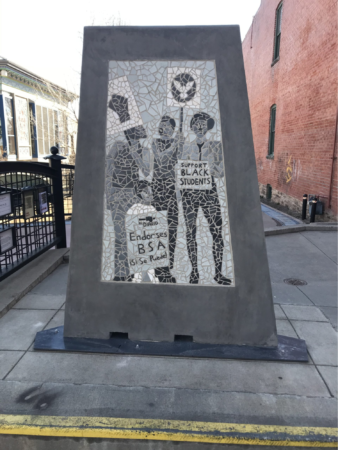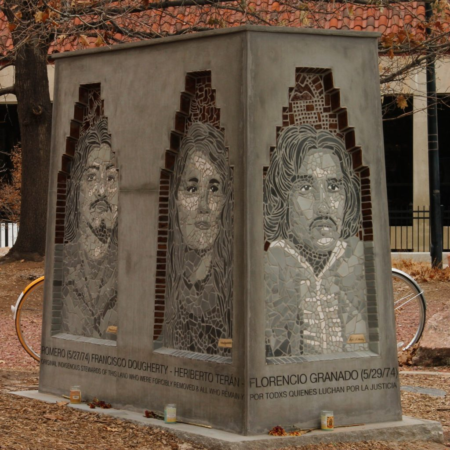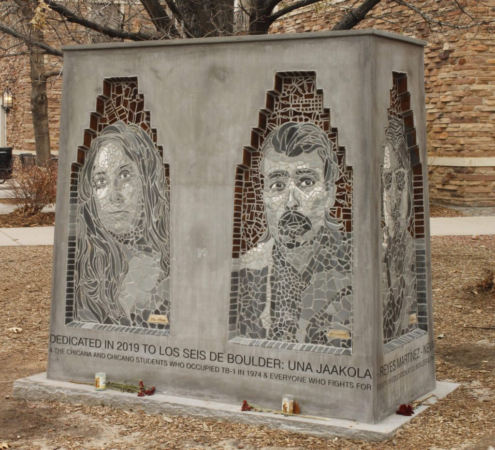Los Seis de Boulder: Gone but Never Forgotten
After 47 years, the case of “The Boulder Six” has never been solved, their legacies live on through their activism.
In May 1974, six CU Boulder Chicano (a term used to describe Mexican-Americans) student activists and alumni were killed in two car bombings near Chautauqua Park and a parking lot by 28th St. and Canyon Blvd. Una Jaakola, Reyes Martínez, Neva Romero, Florencio Granado, Francisco Dougherty and Heriberto Terán tragically lost their lives. Antonio Alcantar was the sole survivor of this horrific incident. According to the Los Seis de Boulder Community Sculpture Project, their deaths were never solved.
In 1968, the United Mexican American Students (UMAS) organization was formed by Mexican-American students at CU Boulder. Juan Espinosa, a CU journalism student at the time, decided to create a newspaper for UMAS. Espinosa told Florencio Granado, the president of UMAS about his plan, which Granado fully supported. The newspaper was called “El Diario de la Gente.” El Diario de la Gente covered stories ranging from Los Seis de Boulder, boycotts, student government campaigns and activism.
“El Diario could also mean ‘The Diary of the People,’ and so what we wanted to do was record our own history and report our own news and that was the intent,” said Juan Espinosa. “We did not get fair coverage in any media and we felt the only way to have fair coverage was to create our own and that was the intent.”
Ricardo Falcón, the assistant director of the UMAS Educational Opportunity Program was fired from CU Boulder because he was known for advocating for students instead of the university’s needs. UMAS students peacefully protested outside of the University Memorial Center because of this decision. Falcón and Granado stopped in Oro Grande, New Mexico while they were on their way to attend a convention for El Partido de La Raza Unida, a Chicano political party. It was there that Granado witnessed Falcón’s murder at the hands of Perry Brunson. According to The New York Times Archives, Perry Brunson was later found not guilty.
In spring of 1974, Chicano students were faced with financial aid difficulties. According to El Diario, “All semester students had been trying to find a remedy to financial aid problems they were having. Many students were unable to pay their rent, buy books, pay tuition and pay for other educational expenses because their financial aid was not being released to them. Some were forced to disenroll from school. UMAS-EOP administrators were not responsive and upper echelon university officials turned a deaf ear to the students’ appeals.”
UMAS students created a blockade inside Temporary Building 1 on May 13, 1974. They created this demonstration in order to receive recognition from the university about financial aid. CU Boulder was only willing to look at the students’ requests after the tragic deaths of students and alumni that later became known as “Los Seis de Boulder.”
On May 27, 1974, Una Jaakola, Reyes Martínez, and Neva Romero were killed near Chautauqua Park. Jaakola, 24, was from Minnesota and graduated from CU Boulder. According to El Diario, she became aware of “the history and the people of the occupied Mexican territories” from her college roommates. Jaakola dated Martínez who also died in the first car bombing. Martínez, 26, was an attorney who graduated from University of Colorado’s School of Law. Romero, 21, was a Junior at CU Boulder who was involved in student government and the blockade inside Temporary Building 1.
On May 29, 1974, Florencio Granado, Francisco Dougherty and Heriberto Terán were killed in a parking lot by 28th St. and Canyon Blvd. Granado, 31, a CU alumnus, was the president of UMAS. According to El Diario, “In a 1972 purge several dozen UMAS students including Florencio were expelled and banned from campus.” Dougherty, 20, a Vietnam War veteran was planning to attend CU Boulder. Dougherty and Terán were reportedly close friends. Terán, 24, attended CU Boulder and became part of UMAS. He became friends with Florencio Granado and Ricardo Falcón. Terán was also expelled and banned from campus.
Jasmine Baetz, a CU Boulder graduate student, learned of “The Boulder Six” from the film, “Symbols of Resistance” which documented the Chicano Movement. In 2019, Baetz designed “The Los Seis de Boulder” sculpture in memory of the six lives lost in May 1974. The sculpture is installed at Temporary Building 1 according to Baetz.
“It’s hard to accept that the killings of Los Seis have been silenced for so long,” said Baetz. “My hope is that the sculpture’s preservation will weaken our institution’s historical amnesia around civil rights struggles at CU Boulder.”
According to El Diario, there are two theories about what happened to “The Boulder Six.” The Boulder community believed that the university was responsible. El Diario wrote, “The official version contends that the occupants of the two vehicles were transporting explosives that detonated accidentally. The community was never given an opportunity to investigate the incidents.”
The Los Seis de Boulder sculpture was built by Baetz, family members, students, community members, and faculty. The sculpture was personally specialized with symbols significant to each individual from “The Boulder Six.” A second sculpture was built in 2020 and was installed earlier this year at the Boulder Museum of Contemporary Art. Baetz said that the second sculpture will “eventually be relocated to 28th St. and Canyon Blvd.”
Photos from Los Seis de Boulder and Boulder Weekly websites.
CU Boulder hosted a virtual symposium, “Los Seis de Boulder, Race and Memory” in remembrance of “The Boulder Six” on Friday, Nov. 5 and Saturday, Nov. 6. Dr. Maria Cotera was the keynote speaker for Friday’s event called, “The Archival Afterlives of Los Seis de Boulder.” Cotera discussed how she has collected an extensive amount of oral histories with her Chicana por mi Raza project. She was inspired by her mother’s work as a Chicano activist and librarian.
“My ‘libraries’ and other information efforts have been my armories; for fighting power structures, for educating communities and convincing communities that they have a right to their tax dollars (by showing them the economics); and connecting communities with directories [and other resources],” said Cotera quoting her mother.
Dr. Nicki Gonzales opened the virtual sessions for Saturday’s event with her talk titled, “We Will Endure: Our Journey to Understand Los Seis de Boulder.” There were numerous virtual sessions presented by people associated with CU Boulder, activists and students.
Jasón Romero Jr., a speaker for Saturday’s event called, “Teaching and Being Taught by Los Seis de Boulder” talked about the historical context of “The Boulder Six” and the importance of teaching their story in schools. “In 1972, the university administration at the time began attacking UMAS, identifying them as reverse-racist and saying their scholarships should not be open to everyone and not just minorities,” said Romero Jr.
Associate Professor of Women and Gender Studies Celeste Montoya spoke at the virtual symposium. “Los Seis is a really important part of the history of the Chicano movement, of Colorado, and of CU Boulder. The activists whose lives were lost in the bombings were participating in activism around issues that are still very pertinent today,” said Montoya. “This includes the occupation of TB1. Students were protesting the lack of adequate financial aid and institutional support for Chicano students and for students of color more broadly.”
The Boulder community, CU Boulder students and faculty need to be aware of the racial injustices that occurred in May 1974 as well as the continuation of racial injustices that happen daily throughout college campuses. We need to learn from the past in order to create a better future by learning about stories like “The Boulder Six.”




